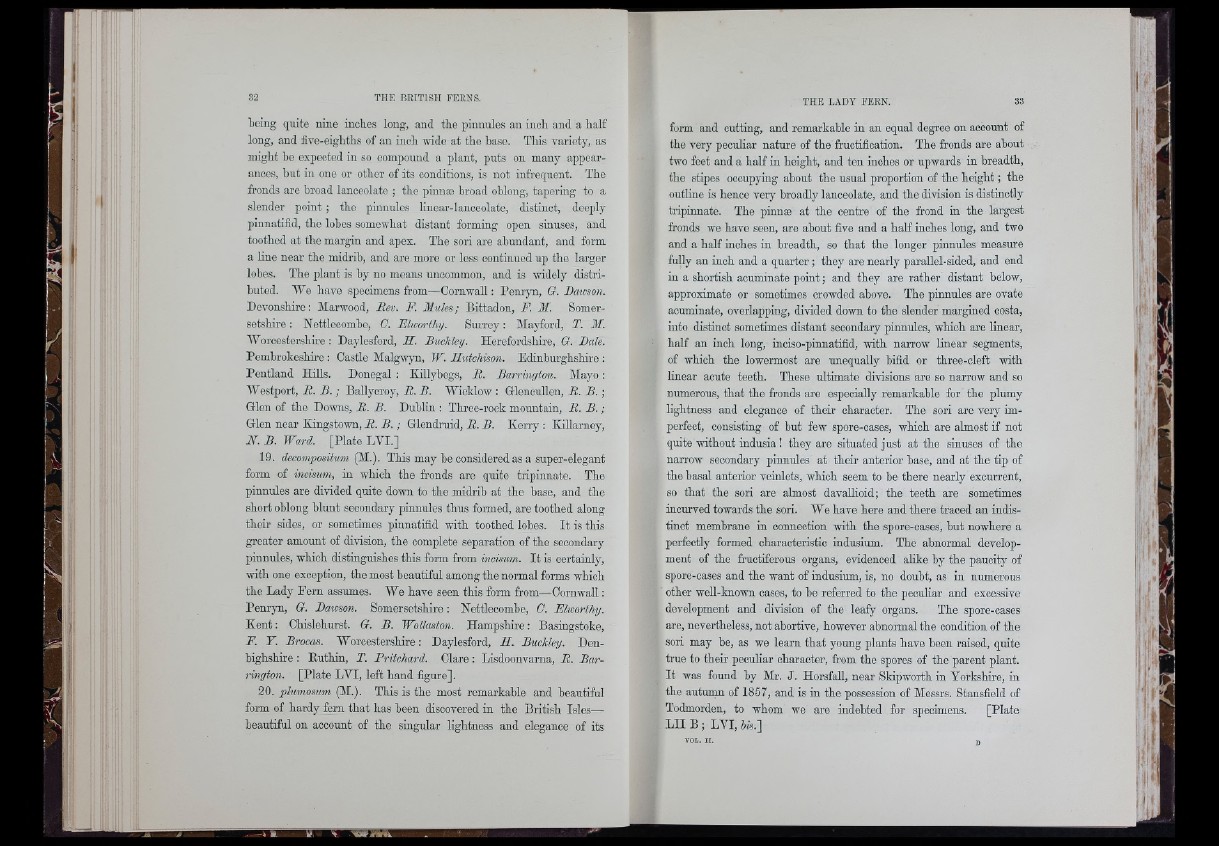
being quite nine inches long, and tbe pinnules an inch and a half
long, and five-eighths of an inch wide at the base. This variety, as
might be expected in so compound a plant, puts on many appearances,
but in one or other of its conditions, is not infrequent. Tbe
fronds are broad lanceolate ; the pinnæ broad oblong, tapering to a
slender point ; the pinnules linear-lanceolate, distinct, deeply
pinnatifid, the lobes somewhat distant forming open sinuses, and
toothed at the margin and apex. The sori are abundant, and form
a lino near the midrib, and are more or less continued up tbe larger
lobes. The plant is by no moans uncommon, and is widely distributed.
We have specimens from—Cornwall : Penryn, G. Bateson.
Devonshire; Marwood, Bee. F. Ilitles; Bittadon, F. M. Somersetshire
: Nettlecombe, C. Elworthy. Surrey : Mayford, T. M.
Worcestershire : Daylesford, H. Buckley. Ilorcfordsliire, G. Bale.
Pembrokeshire : Castle Malgwyn, W. Hutchison. Edinburghshire :
Pentland Hills. Donegal : Killybegs, B. Barrington. Mayo :
Westport, R. B. ; Ballyoroy, R. B. Wicklow : Glenoullen, R. B. ;
Glen of the Downs, R. B. Dublin : Tbroo-rook mountain, R. B. ;
Glen near Kingstown, R. B. ; Glendruid, B. B. Kerry : Killarney,
N. B. Ward. [Plato LVI.]
19. deeompositmn (M.). This may be considered as a super-elegant
form of incisum, in which the fronds are quite tripinnate. The
pinnules are divided quite down to the midrib at the base, and tbe
short oblong blunt secondary pinnules thus formed, are toothed along
their sides, or sometimes pinnatifid with toothed lobes. It is this
greater amount of division, the complete separation of the secondary
pinnules, which distinguishes this form from incisum. It is certainly,
with one exception, the most beautiful among tbe normal forms which
the Lady Fern assumes. We have seen this form from—Cornwall :
Penryn, G. Bawson. Somersetshire : Nettlecombe, 0. Elworthy.
Kent : Ohislehurst. G. B. Wollaston. Hampshire : Basingstoke,
F. T. Brocas. Worcestershire : Daylesford, H. Buckley. Denbighshire
: Euthin, T. Pritchard. Clare : Lisdoonvarna, R. Barrington.
[Plate LYI, left hand figure].
20. plumosum (M.). This is the most remarkable and beautiful
form of hardy fern that has been discovered in the British Isles—
beautiful on account of the singular lightness and elegance of its
form and cutting, and remarkable in an equal degree on account of
the very peouKar nature of the fructification. The fronds are about
two feet and a half in height, and ten inches or upwards in breadth,
the stipes occupying about the usual proportion of the height ; the
outline is hence very broadly lanceolate, and tbe division is distinctly
tripinnate. The pinnæ at the centre of the frond in the largest
fronds we have seen, are about five and a half inches long, and two
and a half inches in breadth, so that the longer pinnules measure
fully an inch and a quarter ; they are nearly parallel-sided, and end
in a shortish acuminate point ; and they are rather distant below,
approximate or sometimes crowded above. The pinnnles are ovate
acuminate, overlapping, divided down to the slender margined costa,
into distmot sometimes distant secondary pinnules, which are Unear,
half an inch long, inciso-pinnatifid, with narrow Knear segments,
of which the lowermost are unequally bifid or throe-cleft with
linear acute teeth. These ultimate divisions are so narrow and so
numerous, that the fronds are especially remarkable for the plumy
lightness and elegance of their character. The sori are very imperfect,
consisting of but few spore-cases, which are almost if not
quite without indusia ! they are situated just at the sinuses of the
narrow secondary pinnules at their anterior base, and at the tip of
the basal anterior veinlets, which seem to be there nearly excurrent,
so that the sori are almost davaUioid; the teeth are sometimes
incurved towards the sori. We have here and there traced an indistinct
membrane in connection with the spore-cases, but nowhere a
perfectly formed characteristic indusium. The abnormal development
of tbe fructiferous organs, evidenced ahke by the paucity of
spore-cases and the want of indusium, is, no doubt, as in numerous
other well-known cases, to be referred to the peculiar and excessive
development and division of the leafy organs. The spore-cases
are, nevertheless, not abortive, however abnormal the condition of the
sori may be, as we learn that young plants have been raised, quite
true to their peculiar character, from the spores of the parent plant.
It was found by Mr. J. HorsfaU, near Skipworth in Yorkshire, in
the autumn of 1857, and is in the possession of Messrs. Stansfleld of
Todmorden, to whom we are indebted for specimens. [Plate
LII B ; LVI, Us.]
VOL. II. „
■
if-' I
( »
I »
I 1 - j